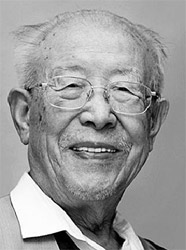 Li Qun (1912-2012, also known as Liqun) was born in Lingshi, Shanxi Province. He entered the Hangzhou National Art School in 1931 or 1932, and participated in the founding of the League of Left-wing artists in 1933. In 1940, he arrived in Yan'an, where he took up teaching at the Lu Xun Institute of Art and Literature (鲁艺, Luyi). He was present at the Yan'an Forum on Literature and Art in 1942, where Mao set the guidelines for art in the future People's Republic. He was appointed Chairman of the Shanxi Provincial Artists' Association in 1949. In 1952, he moved to Beijing, where he worked in the editorial office of the People's Fine Arts Publishing House. He was also involved editorially with the journal Fine Arts (美术, Meishu). In the 1960s, he travelled through China, making woodcuts. In the late 1970s, he returned to take on various ceremonial functions in Taiyuan, Shanxi Province. In 2005 a museum devoted to his art opened in his hometown of Lingshi.
Li Qun (1912-2012, also known as Liqun) was born in Lingshi, Shanxi Province. He entered the Hangzhou National Art School in 1931 or 1932, and participated in the founding of the League of Left-wing artists in 1933. In 1940, he arrived in Yan'an, where he took up teaching at the Lu Xun Institute of Art and Literature (鲁艺, Luyi). He was present at the Yan'an Forum on Literature and Art in 1942, where Mao set the guidelines for art in the future People's Republic. He was appointed Chairman of the Shanxi Provincial Artists' Association in 1949. In 1952, he moved to Beijing, where he worked in the editorial office of the People's Fine Arts Publishing House. He was also involved editorially with the journal Fine Arts (美术, Meishu). In the 1960s, he travelled through China, making woodcuts. In the late 1970s, he returned to take on various ceremonial functions in Taiyuan, Shanxi Province. In 2005 a museum devoted to his art opened in his hometown of Lingshi.
Li was renowned for his woodcuts; his works have been exhibited extensively.
